One of the best lessons that time in nature can teach us is that life can’t always be “go, go, go”. In fact, often times slowing down is crucially important to connecting with the outdoors. Sit-spots are a popular and highly effective practice for engaging with the local flora and fauna of an area. Furthermore, they are an excellent way to get a “dose” of nature’s many benefits to physical and mental health. In this Outdoor Tips post, I’ll share advice on how to do a sit spot.
This post should help you get a feeling for what you can do to have a safe, comfortable, and productive time using a sit spot to connect with nature. You’ll be relaxing and noticing new things about your local outdoor spaces before you know it!
1. Don’t forget snacks and water!

As with any other nature adventure, you’ll want to bring snacks and water if you plan on being out for more than a half hour. For shorter excursions, water should do the trick, but longer sit spots, especially in the cold, often call for food as well. This is especially true if getting to your sit spot requires a long or energy-intensive hike.

If you’ll be out in the cold, a good thermos filled with hot tea or coffee is a great way to go. The extra stimulation helps some people have an easier time focusing on their surroundings.
As for good sit-spot snacks, I recommend things that you can enjoy quietly. If you’re trying to avoid disturbing the surrounding wildlife, you’ll generally want to steer clear of crinkly packages or popping open cans. Here are some good, quiet snacks I’ve used in the past:
- Simple sandwiches (think peanut butter and jelly, or peanut butter and honey)
- Oranges
- Apples
- Bananas
- Trail mix (especially in a re-sealable sandwich bag)
2. Bring a notebook
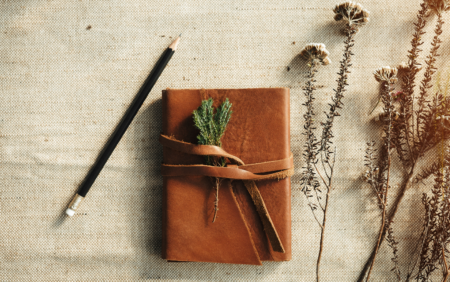
Whether you’re visiting a new place every time, or the same spot over and over, it helps to write down your observations. Over time, this will help you keep track of what you’ve seen, to learn more about local species and their behaviors. If you have a nature journal, it should always be your sit-spot companion.
Even if you aren’t interested in documenting your every outing, a simple notebook can be a helpful tool. You can use it for doodling, writing down thoughts or feelings, or keeping a list of bird species, insects, leaf shapes, or other things you come across.

I highly recommend Rite-in-the-Rain notebooks for nature journals or general recording tools for outdoor adventures. They are durable and keep your notes protected if you use a pencil or waterproof pen. The pages are tear-resistant and don’t break down if they get rained on or dropped in a puddle. This can be a lifesaver if you’re out in wet areas!
3. Engage your senses
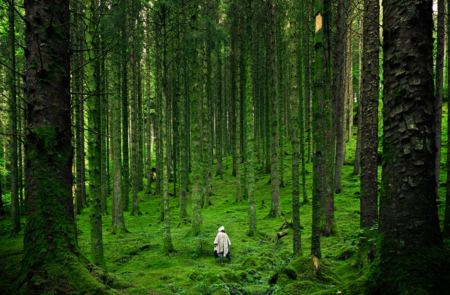
Immersing yourself in nature requires using different senses. This means taking the time to watch, listen, touch, and smell your surroundings. In doing so, you may open up new worlds of discovery or notice things you wouldn’t otherwise have come across.
If you’re a birdwatcher, this can also be a great chance to match sounds in your environment to common bird species. Learning birdsong can be tough, but by standing still in a sit-spot you may get sightings you wouldn’t get otherwise.
4. Turn off your phone

This can be a tough one for people who spend a lot of time on their phones, but is one of the best ways to get more out of your outside time. Turning off your phone will help you do a better sit spot by keeping your mind focused on your surroundings. It can also increase the mental health and stress benefits of going outside by increasing your immersion in nature.
Bringing a notebook or nature journal along can help a lot with unplugging from your phone. This is because your notebook allows you a place to record sightings and thoughts so that you don’t have to rely on apps to do so.
If you want to use an app like Merlin to keep track of singing birds while you’re doing your sit-spot, try putting your phone in Airplane mode. This will let you use some functions of your phone without being pestered by emails and text messages.
5. Pick a safe, comfortable place

Just like finding a home, choosing a sit-spot is all about location! Two major things to consider are safety and comfort. Is your selected spot out of the wind? Does it get too much sunlight in the summertime, making it a bit too hot?
Safety is another important thing to consider. Are there dangerous wildlife in the area? Do lots of people pass through that spot? Do you have phone reception to call for help? Would it be easy to slip and fall, or otherwise be injured?
Ideally, you’ll want to spend lots of time in your sit-spot to maximize stress reduction, learning opportunities for flora and fauna, and nature connection. This means that careful selection of your location, with your safety and comfort in mind, will go a long way.
6. Get a good vantage point
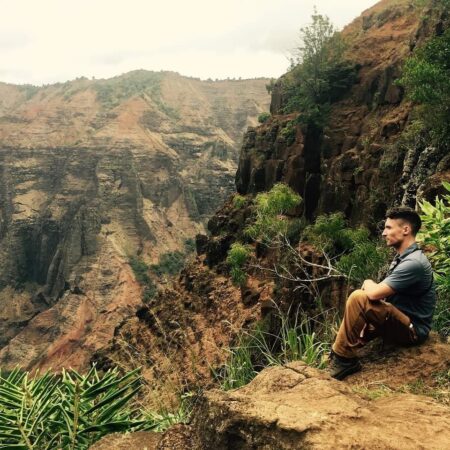
Another important consideration in the location of your sit-spot is what you can see from there. Since the point of a sit-spot is standing still and letting nature come to you, a good viewpoint is key. You won’t want to be getting up and moving around within your sit-spot, since that will likely disturb the surrounding wildlife.
Elevated areas like cliffs or hillsides, or places on the edge of vegetative cover are always a great option. These offer a broader view of the surrounding landscape. Lake, stream, and wetland edges are also fantastic since they open up vegetation while attracting lots of great wildlife.
Alternatively, if you are particularly interested in certain plants or animals, you might select your sit-spot around where they spend their time. For instance, I visited a hillside in Montana for several months to watch burrowing native bees live out their life cycles during the COVID-19 pandemic.
7. Bring optics for a closer look
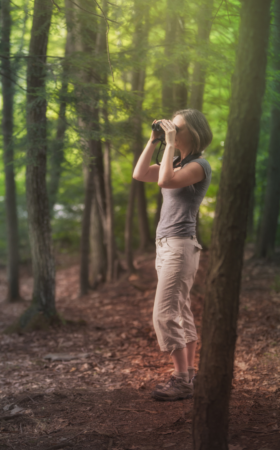
What you can see from your sit-spot will also depend on what tools you can use to examine your surroundings. Whether you’re looking out over a huge area like a lake or valley, or studying a rotting log, bringing optics along makes a big difference.
If you expect to be looking at wildlife across larger distances, a good pair of binoculars goes a long way. Check out my post on how to use binoculars for tips on putting these great optics to use!
Alternatively, you may also want to zoom in on the micro-worlds around you for a closer look. Bringing along a magnifying glass is an easy and effective way to get a more intimate perspective. During one sit spot in Georgia, I found my first-ever globular springtails just by searching the soil next to me with a botany loupe.
8. Take some deep breaths
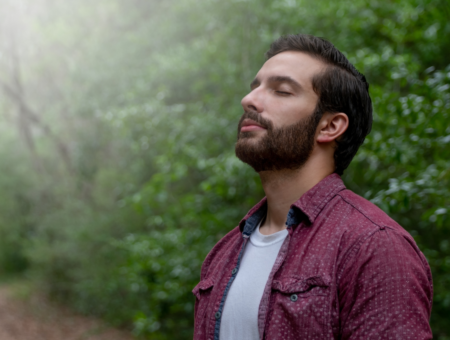
Sit-spots are about slowing down. This is as important for studying nature as it is for finding inspiration and improving your health. One of the best ways to shift gears into a sit-spot state of mind is to take a few deep, slow breaths. I often do this in four parts:
- Breathe in, counting to 5 as you do so.
- Hold your breath for another 5-count.
- Breathe out slowly, counting to 5.
- Wait for another 5-count before breathing in again.
This will help you settle your mind before you begin watching your surroundings. If you close your eyes while you take your breaths, it may also give you a head start in noticing the sounds and smells around you.
When you open your eyes, you may also find that it feels like you’re seeing your surroundings differently. For me, I often find the colors of leaves and trees seem more vibrant after I have taken a few breaths.
9. Focus on what’s around you
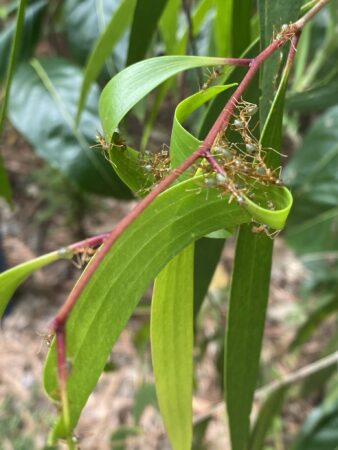
The many stresses of daily life can make it difficult to slow down and concentrate on the beauty of nature. That makes it all the more important to focus on what you’re seeing, hearing, and smelling in outdoor places. By setting your mind to your surroundings, you can practice mindfulness and be present in the space.
This helps you achieve what psychologists call soft fascination, a mental state that boosts brain function and emotional well-being. As you concentrate your mind on a beetle scooting past or an inchworm munching on a leaf, it’s easier to push aside stressful thoughts about other things happening in your life. Those things will still be there when you finish, but taking some time to escape them and focus on nature can be very therapeutic.
10. Pack extra layers just in case
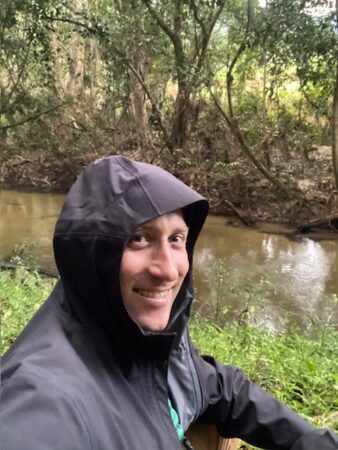
One major difference between sit-spots and other outdoor activities like hiking is standing still. Without the excess heat provided by exercise, even in warmer climates it’s easy to feel cool. Furthermore, the ground is often cooler than our body temperatures. Because of this, we can lose body heat through conduction when we sit on the ground, a log, or a rock for a long period of time.
Bringing an extra layer or two along is a great way to be prepared for this potential cooling. I often bring a rain layer as protection in case it rains, and place it beneath me to keep my pants dry if I sit on wetter ground. A good jacket, gloves, hat, and other warm outdoor clothes are super important for any sit-spotting in the Wintertime.
11. Try sketching something around you

Even if you’re not the best artist (I’m certainly not!), making a sketch or drawing of something in your surroundings can be a great way to focus your attention. Whether you decide to do an in-depth, focused drawing or a quick line sketch is up to you and the amount of time you want to spend.
Another advantage of drawing is that it helps you remember the forms and shapes of the things you find outside. This could be an especially interesting stone, leaf, or insect, or the form of a bird’s wings flying overhead. Sketches also make it easier to identify species in field guides when you get home.
12. Soften your gaze to see more
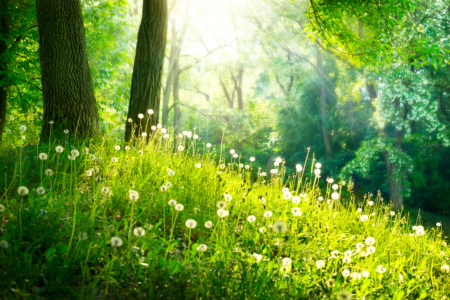
Many naturalists practice seeing differently when they are outdoors to better notice the wildlife around them. Through a process called “softening the gaze”, naturalists deliberately try to de-focus their vision. In other words, they try not to look directly at any one thing, but let their eyes roam over their surroundings.
Furthermore, softening the gaze means paying attention to things in the periphery of your vision as much as things in the center. This can help you notice things you might otherwise have overlooked, like camouflaged animals.
Thanks for reading 12 tips on how to do a sit-spot!
If you haven’t already, go try out these tips on your next sit-spot. Have you had any cool nature observations or sightings while sitting still? Let us know in the comments, on social media, or using the Contact page!

